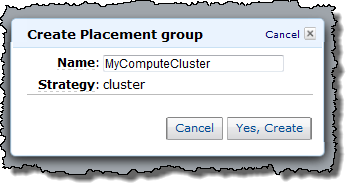AWS News Blog
Next Generation Cluster Computing on Amazon EC2 – The CC2 Instance Type
|
|
You no longer need to build your own compute cluster in order to tackle your High Performance Computing (HPC) projects. By launching cloud-based compute instances on an as-needed basis, you can avoid waiting in lengthy queues for limited access to shared resources.
We’ve pushed the bounds of cloud-based HPC in the past with the introduction of our Cluster Compute and Cluster GPU instances. Both of these instance types have been used in a wide variety of High Performance Computing scenarios.
Today we are introducing a new member of the Cluster Compute Family, the Cluster Compute Eight Extra Large. The API name of this instance is cc2.8xlarge so we’ve taken to calling it the CC2 for short. This instance features some incredible specifications at a remarkably low price. Let’s take a look at the specs:
Processing – The CC2 instance type includes 2 Intel Xeon processors, each with 8 hardware cores. We’ve enabled Hyper-Threading, allowing each core to process a pair of instruction streams in parallel. Net-net, there are 32 hardware execution threads and you can expect 88 EC2 Compute Units (ECU’s) from this 64-bit instance type. That’s nearly 90x the rating of the original EC2 small instance, and almost 3x the rating of the first-generation Cluster Compute instance.
Storage – On the storage front, the CC2 instance type is packed with 60.5 GB of RAM and 3.37 TB of instance storage.
Networking – As a member of our Cluster Compute family, this instance is connected to a 10 Gigabit network and offers low latency connectivity with full bisection bandwidth to other CC2 instances within a Placement Group. You can create a Placement Group using the AWS Management Console:

Pricing – You can launch an On-Demand CC2 instance for just $2.40 per hour. You can buy Reserved Instances, and you can also bid for CC2 time on the EC2 Spot Market. We have also lowered the price of the existing CC1 instances to $1.30 per hour.
You have the flexibility to choose the pricing model that works for you based on your application, your budget, your deadlines, and your ability to utilize the instances. We believe that the price-performance of this new instance type, combined with the number of ways that you can choose to acquire it, will result in a compelling value for scientists, engineers, and researchers.
Operating Systems – This instance type uses hardware-assisted virtualization (HVM), so you’ll need to choose an AMI accordingly. You can use the Amazon Linux AMI or Windows 2008 R2. You can also install HPC Pack 2008 R2 Express (read Microsoft’s HPC Server FAQ for more info).
We have updated the Amazon EC2: Microsoft Windows Guide with instructions on setting up an HPC cluster complete with an Active Directory Domain Controller, a DNS server, a Head Node and one or more Compute Nodes.
Speed – We have submitted benchmark results for HPL to the Top500 site. The November list came out earlier today and we are ranked at position number 42, with a speed of 240.09 teraFLOPS. This result was obtained using a cluster of 1064 instances.
On a somewhat smaller scale, you can launch your own array of 290 CC2 instances and create a Top500 supercomputer (63.7 teraFLOPS) at a cost of less than $1000 per hour (perhaps a lot less, depending on conditions in the Spot Market).
Launch – My colleague Dr. Matt Wood cooked up a CloudFormation template to make it easy for you to get started with CC2 instances. The template uses MIT’s StarCluster to create a fully functioning cluster for loosely coupled or tightly parallel compute tasks with a single click. Matt says that the template will do the following:
- Provision a new 2 node CC2 cluster with 32 hyperthreaded cores, into a new placement group.
- Attach NFS storage, monitoring, and a 200 GB AWS Public Data Set.
The template creates a new t1.micro instance, which acts as a controller for the rest of the elastic cluster. From a basic Amazon Linux AMI, CloudFormation bootstraps all dependencies, installs and configures StarCluster and creates the necessary security credentials before provisioning the CC2 instances which spin up ready to accept jobs via Sun Grid Engine.
You can spin up the stack, log in to the controller instance and hop onto the cluster master to submit jobs, or scale the ad-hoc cluster up and down in just a few clicks. That’s pretty cool for just 169 lines of declarative JSON. You can get started very quickly with this friendly button:
We are making the CC2 instance available as a public beta so a few caveats apply:
- The instances are available in a single Availability Zone in the US East (Northern Virginia) Region. We plan to add capacity in other EC2 Regions throughout 2012. Please feel free to contact us if you are interested in CC2 support in other Regions.
- You can run 2 CC2 instances by default. If you would like to run larger jobs, please submit an EC2 instance increase request.
- You cannot currently launch instances of this type within a Virtual Private Cloud (VPC).
Supercomputing 11 – The AWS team will be out in force at the Supercomputing 11 conference (November 12-18 in Seattle); here’s a summary of AWS activities at SC11. Our booth (#6202) will be open from the 14th to the 17th (come by and say hello). My colleague Dr. Deepak Singh, will participate in a panel on SaaS-Based Research. Deepak will host a BoF session on HPC in the Cloud ; Matt Wood will host a session on Genomics in the Cloud.
What can you do with a supercomputer of your very own?
— Jeff;
